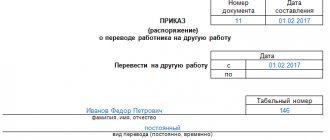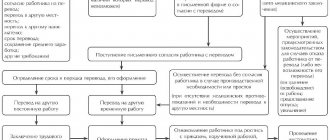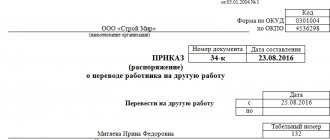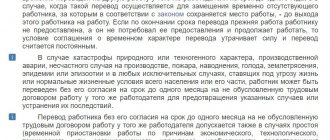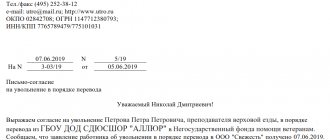Home / Labor Law / Dismissal and layoffs / Dismissal
Back
Published: 04/15/2016
Reading time: 9 min
0
2163
The labor legislation of the Russian Federation provides for two types of employee transfer:
- interior,
- external.
In the first case, it occurs between different departments of the same company; in the second case, the employee is transferred to another organization.
The last type of translation raises the most questions and difficulties. That is why it is worth considering this procedure and the features of its implementation in more detail.
- The essence and features of dismissal with transfer
- Conditions for employee transfer
- Dismissal procedure On the employee’s personal initiative
- With the written consent of the employee
- Upon written request of the new employer
General information
Internal and external transfer to another job
Transfer from work to another can be both internal and external. This depends on the movement of employees within the organization or the release of job vacancies at other enterprises.
More details about translation:
- Internal involves changing jobs in the same organization. The employee has the right to move to another department or change position. This is possible only in agreement with the manager, but the only exceptions are unforeseen circumstances, for example, natural disasters, emergencies and other incidents.
- The concept of external transfer is the complete termination of an employment contract with an employer and the conclusion of an employment agreement with another within a month.
When an employee moves to another place, but if the company remains the same and dismissal is not required.
Features of dismissal
The peculiarity of this form of termination of employment relations is that the employee terminates the professional contract with one employer and immediately enters into it with another. In this case, one condition must be observed: each party to such a process has no objections and agrees to the procedure.
Legislation
The main document providing for the most common and possible forms of termination of employment relationships is the Labor Code. For them, the issue of dismissal due to transfer is regulated in several articles, including as a general reason for breaking a professional contract: articles , , 72.1, 84.1, 169.
Also, the possibility of dismissal by transfer is enshrined in clause 5 of part 1 of article 33 of Federal Law No. 79-FZ of July 27, 2004 “On the State Civil Service of the Russian Federation.” This rule of law applies to state civil servants.
Download for viewing and printing:
Article 64. Guarantees when concluding an employment contract of the Labor Code of the Russian Federation
Article 77. General grounds for termination of an employment contract of the Labor Code of the Russian Federation
Article 72.1. Transfer to another job. Relocation of the Labor Code of the Russian Federation
Article 84.1. General procedure for registering termination of an employment contract under the Labor Code of the Russian Federation
Article 169. Reimbursement of expenses when moving to work in another area of the Labor Code of the Russian Federation
What does the Labor Code of the Russian Federation say about dismissal by transfer?
This type of termination of labor relations is referred to in clause 5 of part 1 of Art. 77 Labor Code of the Russian Federation. Permitted with the consent of the employee himself or his request. Moreover, they must be clearly expressed in writing.
Dismissal process through transfer
Concluding an agreement with another employer is the initiative of the employee himself. The following benefits remain:
- guarantee of employment with another representative of the employer;
- compensation for expenses associated with moving to another area of residence in full.
If an employee is transferred at the latter's request, it is necessary to submit a specially designed letter of invitation to another job from the future employer.
The contents of this letter must include the following information:
- full surname and initials of the employee;
- proposed position;
- when the transition will take place;
- certified by the signature of the head with the details of the organization.
With this letter you must attach a letter of resignation stating the reason for the transfer, and it is recommended to indicate the name of the company in full. If the transfer is initiated by the employer himself, then the transfer to another place of work is carried out by agreement of three parties: the employee and two employers.
Conditions for employee transfer
As already noted, when an employee is transferred to another company, he terminates the employment contract at the old place of work, and enters into a new one at the new one. Therefore, the conditions of his work may also change - no guarantees are provided to the employee regarding the preservation of the previous salary or work responsibilities.
Since dismissal by transfer is a completely voluntary initiative of a subordinate, before starting this procedure he can agree on all the nuances and conditions of work with the future employer.
Often, a transition to another company occurs only in cases where the new conditions are no worse or even better than the previous ones. To obtain additional guarantees, it is worth requesting a letter of request from the new employer indicating the specific position to which the transition will be made.
The advantage is the fact that in the event of dismissal by transfer, the new manager does not have the right to refuse further employment to the employee.
For such a violation he will be subject to liability under Art. 5.27 of the Administrative Code, which consists of both imposing a fine from 30 to 50 thousand rubles, and temporary suspension of work for up to 90 days.
As for annual leave, the transferred employee will have the right to receive it, as in general cases, only after working for six months in a new place. The right to old leave is not transferred to the new company; the employee will only be able to receive it at his previous place of work.
Mandatory work for two weeks, as in the case of terminating an employment contract at will, is also not provided for. All terms (both dismissal and subsequent employment) are agreed upon between managers and subordinates in advance, so this issue is resolved voluntarily.
Organization of the translation process
The procedure for transferring to another job through dismissal
After a package of documents has been collected, it must be submitted to the human resources department or the person who is involved in personnel work. The transfer is carried out according to the following scheme:
- An administrative document is prepared based on the employee’s application or a tripartite agreement.
- The document is agreed upon with the interested parties, after which the employee familiarizes himself with it and signs it.
- A dismissal card is filled out, which also requires the employee’s signature.
- It is required to make an entry in the work book with the date and serial number of the administrative document on dismissal.
- The final payment to the employee is made taking into account all due compensation on the final day of work.
- A work book and a certificate of the employee’s salary for the last 2 years worked at the enterprise are issued.
Leave when transferring within the company
There are often cases when employees get promoted or change the department in which they work. All these situations are internal transfers, i.e. movements within one company (legal entity). At the same time, the employee continues to work in the previous organization without changing the employer. There is no layoff.
Download documents from the article
Consequently, such an employee retains most of the previous constants, such as a personnel number, an employment contract, the right to rest and the number of days off. Since the employee is not fired, he remains included in the vacation schedule and can go on it as planned. Unless a situation arises where the employer has the right to postpone vacation dates.
Changes in leave when transferred to another position within the company
When transferring, leave is retained if such transfer was made within the same enterprise. In the process of formalizing the transfer of an employee from position to position, an additional agreement to the employment contract is drawn up. The text of the agreement must specify all changing terms of the contract:
- new position, division;
- new salary (tariff rate);
- new rules for calculating vacation, etc.
According to the labor code, all workers can count on 28 calendar days of vacation. Therefore, it is impossible to reduce its duration during translation. In addition, if the employee is given an irregular schedule or new working conditions are harmful to his health, he is entitled to additional leave.
Watch a video on the topic:
The amount of additional rest, as a rule, is prescribed in the collective agreement or other company regulations. It would not be superfluous to indicate the additional size. vacation in an additional agreement to the employment contract.
Note! The calculation of length of service for the next vacation for a transferred employee will not change and will be counted from the date of admission. Whereas he has the right to an additional one only after moving
And, accordingly, the countdown of the calendar year will begin from the date of transfer.
Try for free, refresher course
Documentation support for work with personnel
- Meets the requirements of the professional standard “Human Resources Management Specialist”
- For passing - a certificate of advanced training
- Educational materials are presented in the format of visual notes with video lectures by experts
- Ready-made document templates are available that you can download and keep for your work
What compensation is due?
Pay slips are issued on the day of dismissal from the company. These are payments for working time and compensation for unused vacation.
Example of compensation charges. The employee quits on September 30, 2017, but during this year he did not use vacation at all. The duration of the vacation is 28 days. Then the company is required to provide compensation within 14 days.
When transferring to another job, the employee has the following privileges:
- guarantee of employment in another organization within 30 days from the date of dismissal;
- no probationary period is established.
Upon dismissal, all guarantees are lost.
Example #1. Calculation of vacation pay.
Welder of the Atlant foundry, Sidorenko A.M. receives 22,000 rubles here and he decided to leave for another job on May 23, 2021. In May 2021, according to the production calendar, there are 18 working days, that is, in fact, Sidorenko A.M. worked 11 days. Atlanta accounting, based on the work time sheet, revealed the average income of Sidorenko A.M. according to the algorithm of the quotient of his salary and working days, multiplied by the actual period worked:
22,000 / 18 * 11 = 13,444.44 rubles.
May income Sidorenko A.M. is 13,444.44 rubles, but he will receive the amount minus taxes:
13,444.44 rubles * 13% = 1,747.78 rubles – the amount of income tax.
13,444.44 rubles – 1,747.78 rubles –11,696.66 rubles.
How is admission to another organization carried out?
Admission to another organization upon transfer
When an employee starts working in another organization, he must:
- draw up an employment agreement;
- issue an administrative document on employment;
- fill out a personal card;
- make entries in the work book;
- provide instructions;
- obtain permission to work independently in the manner prescribed by regulatory documents.
It is equally important that the future employee undergo a medical examination before applying. Confirmation of health status is important for the employer.
Payment of vacation pay upon dismissal
The dismissal of a subordinate, regardless of the reasons and its conditions, is under the close control of the law (Article 140 of the Labor Code of the Russian Federation). Based on the requirements set out there, management must pay the subordinate in full and give him his salary on the last day of his work in the company. There is an indulgence in terms only in a situation where on such a day a person did not begin to fulfill his work duties, but in this case it is postponed to the next day after the person’s request to calculate it. Payments due upon leaving include:
- The remainder of the basic salary for the actual time worked.
- Compensation for the remaining days of rest.
- Other payments, for example, severance pay in case of staff reduction. They depend on the conditions under which and who is leaving.
Dismissal through transfer for different categories
For some categories of employees, individual solutions are used.
At the legislative level, it is not allowed to transfer young specialists to certain specialties that do not correspond to their profile through dismissal to another job. The transfer of a former student to the specialty in which he received a diploma is only welcome.
However, younger employees themselves should carefully consider their decision, as this will only result in their status being lost. In this case, the state will not be entitled to benefits and compensation payments, and it may be that it will be necessary to return the amounts spent.
But there are also such criteria: when the employee does not pass according to the testimony of the medical commission or the employer does not fulfill basic obligations.
If the employee's probationary period has not expired. During the probationary period, the employee also has the opportunity to transfer. The transfer is carried out as usual.
How to calculate and pay vacation when transferring to another job
It happens that it happens in a company that one of the employees is transferred to another position, which differs not only in the amount of wages, but also in the number of vacation days due to him.
And then the question arises of how to correctly calculate the number of days he should rest and how much vacation pay he needs to pay in connection with these changes.
For example, if an employee previously worked in a position where he was entitled to fifty-six days of vacation, and he worked in this position for some time, and the remaining time he worked in a position where he was entitled to only twenty-eight days of vacation.
How to calculate vacation days?
Examples
Examples of transfer through dismissal
In life practice, there are many examples of transfer through dismissal:
- To transfer to another job, all employees must write a letter of resignation. That's what the leader decided. But the new employer did not accept everyone. The workers had nowhere to go but turn to the courts. Based on the decision made, the employer was punished, and the employees were simply required to be hired.
- The employee informed the employer of his intention to move to work in another organization. But the manager refused to sign the statement, citing the fact that his employee is the only qualified specialist who works on this equipment. In this case, the manager is right and does not violate the law.
- If an employee is on maternity leave, then no one has the right to transfer her to another job without her consent. When an employee signs a number of documents and an application drawn up in her own hand, a translation is made in the prescribed manner.
All cases are considered separately, while other circumstances and states of affairs of both the employee and his manager are taken into account.
Consequences for the employer
If the terms of payment of amounts earned by an employee are violated, the employer may be held liable, both material (Article 234, Article 394 of the Labor Code of the Russian Federation) and administrative (Parts 1, 2 of Article 5.27 of the Code of Administrative Offenses of the Russian Federation).
If his actions are perceived as selfish and the delay exceeds two months, he may be punished under a criminal article. If the employer follows the procedure, such dismissal of the worker does not entail any consequences for him. The only negative: searching for a new employee to fill a vacant position.
If the transfer is found to be illegal (during an inspection, upon receipt of a complaint), then the employee can be reinstated and he is entitled to be paid the average salary and other amounts, including moral damages (Article 394 of the Labor Code).
Download for viewing and printing:
Article 394 of the Labor Code of the Russian Federation “Making decisions on labor disputes regarding dismissal and transfer to another job”
Possibility to save vacation
When an employee changes positions within the same organization, it is very important to understand how to maintain vacation rights.
An employee can be transferred due to a promotion or redistribution of responsibilities. The organization has remained unchanged, so maintaining leave is mandatory in such a situation. The course of events is reflected by the creation of an order at the enterprise to transfer an employee from one division to another or from one position to another. The employee must familiarize himself with the document. This procedure does not provide for any other changes.
In accordance with the current legislation of the Russian Federation, when promoted, the vacation period may increase or the right to additional vacation may appear. In this case, all changes will be counted from the period when the transfer occurred. The previous vacation remains unchanged and is displayed in a specialized schedule.
An employee has the right to vacation only after 6 months of work and not earlier. This period is regulated by the Labor Code of the Russian Federation.
Order
Dismissal due to transfer cannot be carried out without an order. It should contain:
- full name of the company;
- Name;
- publication date;
- description of the method of termination of the employment relationship;
- Full name of the person being dismissed, his position, number according to the report card;
- links to documents confirming the legality of dismissal;
- signature of the general director;
- company stamp.
At the end of the order there should be a column entitled “I have read the order,” where the employee confirms the notice of dismissal with his signature. The information is entered into the employee’s personal card on the basis of this document, and a copy of the order and a receipt confirming the absence of material claims against the employee from the company are also attached to it. The order must also be numbered.
